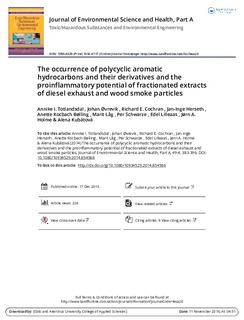| dc.contributor.author | Herseth, Jan Inge | |
| dc.contributor.author | Cocheran, Richard | |
| dc.contributor.author | Schwarze, Per E | |
| dc.contributor.author | Bølling, Anette Kocbach | |
| dc.contributor.author | Kubatova, Alena | |
| dc.contributor.author | Låg, Marit | |
| dc.contributor.author | Øvrevik, Johan | |
| dc.contributor.author | Holme, Jørn Andreas | |
| dc.contributor.author | Lilleaas, Edel | |
| dc.contributor.author | Totlandsdal, Annike Irene | |
| dc.date.accessioned | 2018-08-07T11:00:24Z | |
| dc.date.available | 2018-08-07T11:00:24Z | |
| dc.date.created | 2013-08-27T14:58:33Z | |
| dc.date.issued | 2014 | |
| dc.identifier.citation | Journal of Environmental Science and Health. Part A: Toxic/Hazardous Substances and Environmental Engineering. 2014, 49 (4), 383-396. | |
| dc.identifier.issn | 1093-4529 | |
| dc.identifier.uri | http://hdl.handle.net/11250/2507821 | |
| dc.description.abstract | Exposure to combustion emissions, including diesel engine exhaust and wood smoke particles (DEPs and WSPs), has been associated with inflammatory responses. To investigate the possible role of polycyclic aromatic hydrocarbons (PAHs) and PAH-derivatives, the DEPs and WSPs methanol extracts were fractionated by solid phase extraction (SPE), and the fractions were analyzed for more than ~120 compounds. The pro-inflammatory effects of the fractionated extracts were characterized by exposure of bronchial epithelial lung cells (BEAS-2B). Both native DEPs and WSPs caused a concentration-dependent increase in IL-6 and IL-8 release and cytotoxicity. This is consistent with the finding of a rather similar total content of PAHs and PAH-derivatives. Yet, the samples differed in specific components, suggesting that different species contribute to the toxicological response in these two types of particles. The majority of the IL-6 release and cytotoxicity was induced upon exposure to the most polar (methanol) SPE fraction of extracts from both samples. In these fractions hydroxy-PAHs, carboxy-PAHs were observed along with nitro-amino-PAHs in DEP. However, the biological effects induced by the polar fractions could not be attributed only to the occurrence of PAH-derivatives. The present findings indicate a need for further characterization of organic extracts, beyond an extensive analysis of commonly suspected PAH and PAH-derivatives. | |
| dc.language.iso | eng | |
| dc.title | The occurrence of polycyclic aromatic hydrocarbons and their derivatives and the proinflammatory potential of fractionated extracts of diesel exhaust and wood smoke particles | |
| dc.type | Peer reviewed | |
| dc.type | Journal article | |
| dc.subject.nsi | VDP::Toksikologi: 730 | |
| dc.subject.nsi | VDP::Toxicology: 730 | |
| dc.source.pagenumber | 383-396 | |
| dc.source.volume | 49 | |
| dc.source.journal | Journal of Environmental Science and Health. Part A: Toxic/Hazardous Substances and Environmental Engineering | |
| dc.source.issue | 4 | |
| dc.identifier.doi | 10.1080/10934529.2014.854586 | |
| dc.identifier.cristin | 1045338 | |
| cristin.unitcode | 7502,0,0,0 | |
| cristin.unitcode | 7502,4,5,0 | |
| cristin.unitname | Folkehelseinstituttet | |
| cristin.unitname | Luft og støy | |
| cristin.ispublished | true | |
| cristin.fulltext | original | |
| cristin.qualitycode | 1 | |
